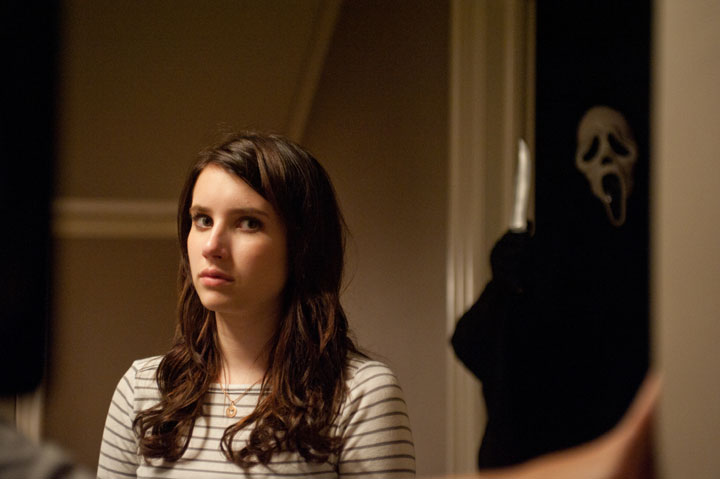Culture
The Bloody Truth: “Scream 4”

Every Thursday in The Bloody Truth, Calhoun Kersten digs out the subtexts lying within many modern horror films.
The Scream franchise has always been a problematic one for me. True, its mix of exploitation, gore and a fair amount of humor should make for a good time, but moments supposed to come off as tense or suspenseful always seem to come off as cheap, often relying on the very conventions of horror that Craven and Williamson had mocked only moments before. But, I can’t write off the franchise completely. After all, it is my childhood. For a brief moment in movie history, the slasher was alive and well again thanks to cookie cutter, horror-lite (that’s half the substance, half the scares with that same great taste you loved from the likes of Freddy and Jason) movies like Urban Legend, I Know What You Did Last Summer and Scream. Why, then, has Scream been the only one to continue on, to enjoy success even a decade and change later?
One theory is that it’s all about the killer. Ghostface easily remains one of the most unsettling slasher villains. Part of this is due to the way his murders always seem to play out. While there’s definitely some inconsistency with his approach, considering many of his victims are merely sliced and diced with no warning, the iconic call and the whole “what’s your favorite scary movie?” line have been immortalized in pop culture and continue to effectively deliver to this day.
But, even as a slasher fanatic, I don’t want to give too much credit to the knife-wielding psycho. In franchises such as Craven’s earlier work on A Nightmare on Elm Street or the Sean Cunningham-helmed Friday the 13th, I would say that the investment is absolutely with the killer and his methods of disposing of his teen victims. But with Scream, the focus stays on the victim, Sidney Prescott (Neve Campbell). With Scream 4‘s release last year, it became one of the longest-running franchises to have the original cast return for all four movies. When Craven and company insist on delivering their “victims” consistently, it inadvertently shifts the focus from the killer or killers, who change in every movie, to the one constant that remains, which is Sidney. You could make the same case for Dewey (David Arquette) and Gale (Courtney Cox), but their off-handed treatment and side storylines suggest a very different approach to their character development.
Returning to Sidney, Scream 4’s focus on her is not only uncharacteristic of the slasher genre, aside from Halloween‘s Laurie Strode but for entirely different reasons, but it’s particularly telling about the attitudes toward women at the time of the film’s production. This should by no means be construed as an indictment of Williamson or Craven, but the first few films of the franchise seemed to suggest the death of feminism as a whole. At some point, it felt as if women had lost their potency or their urgency to be seen as equals in filmic representation, and they were once again relegated to the role of the victim. Many film theorists have suggested that this is due to society’s acceptance of women’s portrayal of terror, such as the bloodcurdling scream, which we are less likely to accept from a male character.
Still, I think the most telling, and potentially damning, thing about the franchise can be found in each movie’s ending. In the first film, the audience understands that it’s Sidney’s first time around. We are forgiving of minor mistakes, because there’s nothing that indicates she should be able to tell who is behind these killings. Even though the movie strongly hints at the identity of the killer/killers, Sidney remains unaware, as does the audience. By the time the second movie comes around, and Sidney is thrown back into the game, she simply crumbles. The trauma of the events of the first movie were too much for her, and we see her completely withdraw and fall apart in moments of crisis. By the time the third movie comes around, she’s become a little wiser. She still has those telling moments of panic, but as a whole seems to have grown stronger. This could serve as strong evidence of a feminist undertone, but once again, we see her emotions as a weakness, and the fact that Dewey is responsible for actually killing the killer seems to suggest that, once again, Sidney is confined to her victimhood.
That’s where Scream 4 comes in. With 10 years elapsed since the events of the last film, there’s enough time for the character of Sidney to show some actual growth. She’s no longer content to be a victim or passive in the events of the film. She’s shown as taking charge, and on several occasions actually physically fighting back with no assistance, male or otherwise. Even in tense moments, which previously featured a panting Neve Campbell running away, we see strategy. We see her best attempts to use wit and her physicality to fight back in a way that was strangely missing from the earlier films. It’s nice to finally see a little respect for the heroine as we’ve watched her shed her victimhood complex, and begin to own and appreciate herself as a survivor and an integral part of the modern horror experience.